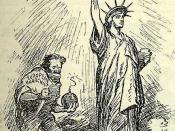After world war one, in the years 1915-1920, the United States went through a outburst of fear and paranoia known as the Red Scare. It was the widespread anxiety brought on by a war that had dragged the U.S. into European affairs. The war years had brought economic and social dislocations followed by post-war uncertainties. The nation's image, cast in the context of isolationism and in opposition to the corruption and militarism of the world, was now subject to question and debate. Under these circumstances, a movement grew around the assumed need to keep the country one hundred percent American.
During World War I, patriotism was widespread in the country, increased by propagandists such as George Creel, chairman of the United States Committee on Public Information. Anyone who wasn't as patriotic as possible - conscientious objectors, draft dodgers, "slackers," German-Americans, immigrants, Communists - was suspect. It was out of this patriotism that the Red Scare took hold.
Hysteria struck Seattle after the Seattle Strike of 1919. On January 21, 35,000 workers went on strike. They were labeled as Reds who were trying to incite a revolution. Department stores, pharmacies, and grocery stores were flooded with frightened customers who were getting ready for the prolonged strike. National news predicted the demise of Seattle to the Reds. All strikes were deemed ÃÂcrimes against societyÃÂ, ÃÂconspiracies to the governmentÃÂ, and ÃÂplots to establish communism.ÃÂEven the government was not immune to anti-communistic hysteria. J. E. Hoover had a mission to uncover Bolshevik Conspiracies and to find all conspirators. These efforts resulted in the imprisonment thousands of radicals and leftists. Many civil liberties were sacrificed and warrants were not used.
Threatening the American character was not only continued involvement in post-war European affairs, which was viewed as dangerously innovative, but also the introduction of un-American ways and values. Suddenly, political cartoons in newspapers that months earlier had been virulently opposed to Reds now featured over zealous Red-hunters as their objects of scorn and ridicule. Industry leaders, who were early proponents of anti-communism, began to realize that deporting immigrants (as many of the communists were alleged to be) drained a major source of labor, which would result in higher wages and decreased profits.
http://www.atomicforum.org/russia/russia.htmlBinder & Reimers, Chapter 8





